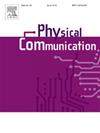Performance analysis of IRS-assist dual-hop wireless communication system
IF 2
4区 计算机科学
Q3 ENGINEERING, ELECTRICAL & ELECTRONIC
引用次数: 0
Abstract
The IRS-assist or smart radio environment technique is a widely developing technology that network providers can use to establish sustained connectivity between end-user terminals and central data units for the next-generation wireless standards. This article introduced a simple and more accurate link-switching technique for dual-hop communication: a single link-switching threshold (SLST) algorithm to provide an uninterrupted linkage between the transceiver terminals. Depending on the severity of the communicating channel under a dual-hop system, links can do auto switches between themselves and furnish continuous connectivity between end-user terminals. Due to a discrete number of phase shifts of the IRS elements, phase and quantization errors are induced in the channel; the proposed system can also optimize the phase and quantization errors. Besides, this work investigates improving the physical layer performance of the dual-hop wireless communication system under the combined effect of phase shift and quantization error with the introduction of the SLST method. For this particular, three performance metrics have been encountered: the outage probability (OP), average bit error rate (ABER), and average capacity (bits/s/Hz). A new, more accurate mathematical framework using the Meijer’G function has been constructed to evaluate worthwhile analytical derivation. Under analytical calculation, we have assumed the primary link experienced with common Rayleigh fading and the IRS-assist link (IAL) experienced with Nakagami-m distribution due to a large number of reflecting elements in the system. The proposed dual-hop system furnishes noteworthy benefits for each performance metric rather than individual links. Moreover, the suitable selection of quantization level and a number of reflecting elements confirm the exhibition of satisfactory outcomes and minimize the channel hardness of the system. Additionally, numerical simulation results from MATLAB, using Monte Carlo simulation, have been added to validate the analytical outcomes for every performance measure.
irs辅助双跳无线通信系统的性能分析
irs辅助或智能无线电环境技术是一项广泛发展的技术,网络提供商可以使用该技术在终端用户终端和下一代无线标准的中央数据单元之间建立持续连接。本文介绍了一种用于双跳通信的简单而更精确的链路交换技术:单链路交换阈值(SLST)算法,用于在收发器终端之间提供不间断的链接。在双跳系统下,根据通信信道的严重程度,链路可以在自己之间自动切换,并提供终端用户终端之间的连续连接。由于IRS元件相移的离散次数,在信道中会引起相位误差和量化误差;该系统还可以优化相位误差和量化误差。此外,本文还研究了引入SLST方法在相移和量化误差共同作用下提高双跳无线通信系统物理层性能的问题。对于这种情况,遇到了三个性能指标:中断概率(OP)、平均误码率(ABER)和平均容量(bits/s/Hz)。一个新的,更精确的数学框架使用梅杰函数已经构建评估有价值的解析推导。在解析计算中,由于系统中有大量反射元件,我们假设主链路经历共同瑞利衰落,irs -辅助链路(IAL)经历中agami-m分布。所提出的双跳系统为每个性能指标提供了显著的好处,而不是单个链路。此外,适当选择量化水平和一些反射元素,确保了系统显示满意的结果,并使系统的通道硬度最小化。此外,还添加了使用蒙特卡罗模拟的MATLAB数值模拟结果,以验证每个性能度量的分析结果。
本文章由计算机程序翻译,如有差异,请以英文原文为准。
求助全文
约1分钟内获得全文
求助全文
来源期刊

Physical Communication
ENGINEERING, ELECTRICAL & ELECTRONICTELECO-TELECOMMUNICATIONS
CiteScore
5.00
自引率
9.10%
发文量
212
审稿时长
55 days
期刊介绍:
PHYCOM: Physical Communication is an international and archival journal providing complete coverage of all topics of interest to those involved in all aspects of physical layer communications. Theoretical research contributions presenting new techniques, concepts or analyses, applied contributions reporting on experiences and experiments, and tutorials are published.
Topics of interest include but are not limited to:
Physical layer issues of Wireless Local Area Networks, WiMAX, Wireless Mesh Networks, Sensor and Ad Hoc Networks, PCS Systems; Radio access protocols and algorithms for the physical layer; Spread Spectrum Communications; Channel Modeling; Detection and Estimation; Modulation and Coding; Multiplexing and Carrier Techniques; Broadband Wireless Communications; Wireless Personal Communications; Multi-user Detection; Signal Separation and Interference rejection: Multimedia Communications over Wireless; DSP Applications to Wireless Systems; Experimental and Prototype Results; Multiple Access Techniques; Space-time Processing; Synchronization Techniques; Error Control Techniques; Cryptography; Software Radios; Tracking; Resource Allocation and Inference Management; Multi-rate and Multi-carrier Communications; Cross layer Design and Optimization; Propagation and Channel Characterization; OFDM Systems; MIMO Systems; Ultra-Wideband Communications; Cognitive Radio System Architectures; Platforms and Hardware Implementations for the Support of Cognitive, Radio Systems; Cognitive Radio Resource Management and Dynamic Spectrum Sharing.
 求助内容:
求助内容: 应助结果提醒方式:
应助结果提醒方式:


